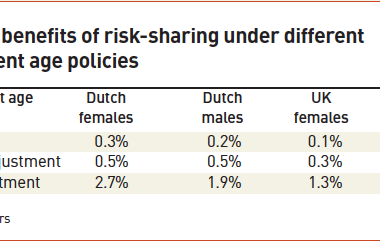Some pension schemes could see their liabilities rise by more than 1% after recent mortality data indicated an increase in longevity improvements.
Data from the Continuous Mortality Investigation (CMI) for the first half of 2019 showed that England and Wales had experienced lower “standard mortality rates” (SMRs) than in 2018.
The CMI’s data feeds into the longevity calculations for many UK defined benefit (DB) pension schemes. Last year, a period of higher mortality led to a reduction in the rate at which longevity was improving, which in turn reduced pension scheme liabilities by an estimated 2.5%.
Steven Baxter, head of research and development at longevity data specialist Club Vita, said: “It seems that after many years of doom and gloom for longevity in the UK we may finally have some good news to share.
“The combination of a mild winter and a fairly benign flu season means that the first half of 2019 has followed in the footsteps of the second half of 2018. In fact, the first six months of this year have seen the lowest deaths on record since 2014.
“If this trend continues then we can expect to see headlines in 2020 revising our current life expectancy predictions upwards. Pension schemes and insurers should pay close attention to these trends as those who followed the latest model from the CMI could find their liabilities increasing by well over 1%.”
Consultancy group XPS estimated earlier this year that 82% of DB schemes had updated their longevity assumptions to reflect the most recent data. This was based on an analysis of 150 of the firm’s clients.
Conor O’Reilly, head of analytics at Club Vita, said there was likely to be “at least some bounce back” in annuity values and liabilities when the CMI’s next model was published. Liability valuations could rise back to levels seen in 2017, he added.
Looking further into the future, O’Reilly said there remained “plenty of scope for things to change in the remaining half of the year” given record-breaking temperatures recorded in July.
“We need to consider whether any ‘bounce back’ in 2019 is expected to be a blip or a return towards the high levels of mortality improvements seen through much of the 2000s,” he said.
A report by KPMG published in May warned of a “lost decade” in mortality improvements among DB scheme members after the CMI’s 2018 model was released.
KPMG’s data meant that, for someone currently aged 45, their assumed pension scheme life expectancy at age 65 would fall to around 23 years in 2019 – a level last seen in 2009. Between 2012 and 2015, assumed life expectancy was roughly one year higher at just over 24 years.
For a pension scheme member already aged 65, assumed life expectancy in KPMG’s survey fell to 21.9 years, the lowest since 2010.




























No comments yet